| Revision as of 13:24, 11 November 2015 editSeptate (talk | contribs)Extended confirmed users2,303 edits CorrectionTags: Mobile edit Mobile web edit← Previous edit | Revision as of 17:34, 11 November 2015 edit undoNillurcheier (talk | contribs)Extended confirmed users7,133 edits Sorry, but REMID and the official church data are much more reliable than your source, see also talk pageNext edit → | ||
| Line 49: | Line 49: | ||
| Two main developments reshaped religion in Germany after 1814. Across the land, there was a movement to unite the larger Lutheran and the smaller Reformed Protestant churches. The churches themselves brought this about in Baden, Nassau, and Bavaria. However, in Prussia King ] was determined to handle unification entirely on his own terms, without consultation. His goal was to unify the Protestant churches, and to impose a single standardized liturgy, organization and even architecture. The long-term goal was to have fully centralized royal control of all the Protestant churches. In a series of proclamations over several decades the ] was formed, bringing together the more numerous Lutherans, and the less numerous Reformed Protestants. The government of Prussia now had full control over church affairs, with the king himself recognized as the leading bishop. Opposition to unification came from the "Old Lutherans" in Silesia who clung tightly to the theological and liturgical forms they had followed since the days of Luther. The government attempted to crack down on them, so they went underground. Tens of thousands migrated, ], and especially to the United States, where they formed the ], which is still in operation as a conservative denomination. Finally in 1845 a new king ] offered a general amnesty and allowed the Old Lutherans to form a separate church association with only nominal government control.<ref>Christopher Clark, ''Iron Kingdom '' (2006) pp 412-19</ref><ref>Christopher Clark, "Confessional policy and the limits of state action: Frederick William III and the Prussian Church Union 1817–40." ''Historical Journal'' 39.04 (1996) pp: 985-1004. </ref><ref>Hajo Holborn, ''A History of Modern Germany 1648-1840'' (1964) pp 485-91</ref> | Two main developments reshaped religion in Germany after 1814. Across the land, there was a movement to unite the larger Lutheran and the smaller Reformed Protestant churches. The churches themselves brought this about in Baden, Nassau, and Bavaria. However, in Prussia King ] was determined to handle unification entirely on his own terms, without consultation. His goal was to unify the Protestant churches, and to impose a single standardized liturgy, organization and even architecture. The long-term goal was to have fully centralized royal control of all the Protestant churches. In a series of proclamations over several decades the ] was formed, bringing together the more numerous Lutherans, and the less numerous Reformed Protestants. The government of Prussia now had full control over church affairs, with the king himself recognized as the leading bishop. Opposition to unification came from the "Old Lutherans" in Silesia who clung tightly to the theological and liturgical forms they had followed since the days of Luther. The government attempted to crack down on them, so they went underground. Tens of thousands migrated, ], and especially to the United States, where they formed the ], which is still in operation as a conservative denomination. Finally in 1845 a new king ] offered a general amnesty and allowed the Old Lutherans to form a separate church association with only nominal government control.<ref>Christopher Clark, ''Iron Kingdom '' (2006) pp 412-19</ref><ref>Christopher Clark, "Confessional policy and the limits of state action: Frederick William III and the Prussian Church Union 1817–40." ''Historical Journal'' 39.04 (1996) pp: 985-1004. </ref><ref>Hajo Holborn, ''A History of Modern Germany 1648-1840'' (1964) pp 485-91</ref> | ||
| From the religious point of view of the typical Catholic or Protestant, major changes were underway in terms of a much more personalized religiosity that focused on the individual more than the church or the ceremony. The rationalism of the late 19th century faded away, and there was a new emphasis on the psychology and feeling of the individual, especially in terms of contemplating |
From the religious point of view of the typical Catholic or Protestant, major changes were underway in terms of a much more personalized religiosity that focused on the individual more than the church or the ceremony. The rationalism of the late 19th century faded away, and there was a new emphasis on the psychology and feeling of the individual, especially in terms of contemplating sinfuness, redemption, and the mysteries and the revelations of Christianity. ] were common among Protestants. Among Catholics there was a sharp increase in popular pilgrimages. In 1844 alone, half a million pilgrims made a pilgrimage to the city of Trier in the Rhineland to view the ], said to be the robe that Jesus wore on the way to his crucifixion. Catholic bishops in Germany had historically been largely independent Of Rome, but now the Vatican exerted increasing control, a new "]" of Catholics highly loyal to Rome.<ref>Christopher Clark, ''Iron Kingdom '' (2006) pp 419-21</ref> A sharp controversy broke out in 1837-38 in the largely Catholic Rhineland over the religious education of children of mixed marriages, where the mother was Catholic and the father Protestant. The government passed laws to require that these children always be raised as Protestants, contrary to Napoleonic law that had previously prevailed and allowed the parents to make the decision. It put the Catholic Archbishop under house arrest. In 1840, the new King Frederick William IV sought reconciliation and ended the controversy by agreeing to most of the Catholic demands. However Catholic memories remained deep and led to a sense that Catholics always needed to stick together in the face of an untrustworthy government.<ref>Holborn, ''A History of Modern Germany 1648-1840'' (1964) pp 498-509</ref> | ||
| ===1870s: Kulturkampf=== | ===1870s: Kulturkampf=== | ||
Revision as of 17:34, 11 November 2015
Religion in Germany (2015 estimate)
Non-religious (34.1%) Roman Catholicism (30.0%) Protestantism (29.9%) Islam (3.9%) Other Christian (1.6%) Others (0.5%)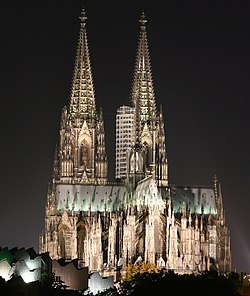
Christianity is the largest religion in Germany, with an estimated 61.5% of the country's total population being member of various Christian denominations. However, a 2011 estimate reported a slightly higher percentage of 66.8% for adherents of Christianity. The second largest religion is Islam with approximately 3.6 million adherents (3.9% of the total population), of which 1 million (1.1%) have German citizenship. There is also a smaller but growing presence of other religions such as Buddhism, Hinduism and Judaism.
During the last decades, the two largest churches, namely the Protestant Evangelical Church in Germany and the Roman Catholic Church, have lost significant number of adherents. Both accounted for about 30% of the population in 2015. An estimated 34.1% of the country's population is not affiliated with any church or religion and around 0.5% of the population belongs to some other religious group.
Since the reunification of Germany the number of non-religious people has grown, especially because of the former East Germany, which was an atheist and communist puppet state. Various churches were put under the pressure by the communist government for roughly 40 years, resulting in people's abandonment of religion.
History
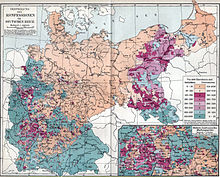
Reformation
Main article: Protestant ReformationRoman Catholicism was the sole established religion in the Holy Roman Empire until the advent of the Protestant Reformation changed this drastically. In the early 16th century there was much discontent occasioned by abuses such as selling indulgences in the Catholic Church, and a general desire for reform. In 1517 the Reformation began with the publication of Martin Luther's 95 Theses which detailed 95 assertions Luther believed to show corruption and misguidance within the Catholic Church. It demonstrated Luther's disagreement both with the way in which the higher clergy, especially the pope, used and abused power, and with the very idea of the pope. In 1521 Luther was outlawed at the Diet of Worms. But the Reformation spread rapidly. Luther translated the Bible from Latin to German, establishing the basis of the German language. A curious fact is that Luther spoke a dialect which had minor importance in the German language of that time. After the publication of his Bible, his dialect evolved into what is now the modern German.

With the protestation of the Lutheran princes at the Imperial Diet of Speyer (1529) and rejection of the Lutheran "Augsburg Confession" at Augsburg (1530), a separate Lutheran church emerged.

From 1545 the Counter-Reformation began in Germany. The main force was provided by the Jesuit order. It restored Catholicism to many areas. The Holy Roman Empire became religiously diverse; for the most part, the states of northern and central Germany became Protestant (chiefly Lutheran, but also Calvinist/Reformed), while the states of southern Germany and the Rhineland largely remained Catholic. In 1547, Holy Roman Emperor Charles V defeated the Schmalkaldic League, an alliance of Protestant rulers. The Peace of Augsburg in 1555 brought recognition of the Lutheran faith. But the treaty also stipulated that the religion of a state was to be that of its ruler (Cuius regio, eius religio).
In 1608/1609 the Protestant Union and the Catholic League were formed. The Thirty Years' War (1618–1648) was one of the most destructive conflicts in European history. The war was fought primarily in German lands, and involved most of the countries of Europe. It was largely a religious conflict between Protestants and Catholics.
1790-1870
Main article: Prussian Union of churches
Two main developments reshaped religion in Germany after 1814. Across the land, there was a movement to unite the larger Lutheran and the smaller Reformed Protestant churches. The churches themselves brought this about in Baden, Nassau, and Bavaria. However, in Prussia King Frederick William III was determined to handle unification entirely on his own terms, without consultation. His goal was to unify the Protestant churches, and to impose a single standardized liturgy, organization and even architecture. The long-term goal was to have fully centralized royal control of all the Protestant churches. In a series of proclamations over several decades the Church of the Prussian Union was formed, bringing together the more numerous Lutherans, and the less numerous Reformed Protestants. The government of Prussia now had full control over church affairs, with the king himself recognized as the leading bishop. Opposition to unification came from the "Old Lutherans" in Silesia who clung tightly to the theological and liturgical forms they had followed since the days of Luther. The government attempted to crack down on them, so they went underground. Tens of thousands migrated, to South Australia, and especially to the United States, where they formed the Missouri Synod, which is still in operation as a conservative denomination. Finally in 1845 a new king Frederick William IV offered a general amnesty and allowed the Old Lutherans to form a separate church association with only nominal government control.
From the religious point of view of the typical Catholic or Protestant, major changes were underway in terms of a much more personalized religiosity that focused on the individual more than the church or the ceremony. The rationalism of the late 19th century faded away, and there was a new emphasis on the psychology and feeling of the individual, especially in terms of contemplating sinfuness, redemption, and the mysteries and the revelations of Christianity. Pietistic revivals were common among Protestants. Among Catholics there was a sharp increase in popular pilgrimages. In 1844 alone, half a million pilgrims made a pilgrimage to the city of Trier in the Rhineland to view the Seamless robe of Jesus, said to be the robe that Jesus wore on the way to his crucifixion. Catholic bishops in Germany had historically been largely independent Of Rome, but now the Vatican exerted increasing control, a new "ultramontanism" of Catholics highly loyal to Rome. A sharp controversy broke out in 1837-38 in the largely Catholic Rhineland over the religious education of children of mixed marriages, where the mother was Catholic and the father Protestant. The government passed laws to require that these children always be raised as Protestants, contrary to Napoleonic law that had previously prevailed and allowed the parents to make the decision. It put the Catholic Archbishop under house arrest. In 1840, the new King Frederick William IV sought reconciliation and ended the controversy by agreeing to most of the Catholic demands. However Catholic memories remained deep and led to a sense that Catholics always needed to stick together in the face of an untrustworthy government.
1870s: Kulturkampf
Main article: KulturkampfThis article has multiple issues. Please help improve it or discuss these issues on the talk page. (Learn how and when to remove these messages)
|

Bismarck would not tolerate any a base of power outside Germany—in Rome—having a say in German affairs. He launched a Kulturkampf ("culture war") against the power of the pope and the Catholic Church in 1873, but only in Prussia. This gained strong support from German liberals, who saw the Catholic Church as the bastion of reaction and their greatest enemy. The Catholic element, in turn, saw in the National-Liberals as its worst enemy and formed the Center Party.
Catholics, although about a third of the national population, were seldom allowed to hold major positions in the Imperial government, or the Prussian government. After 1871, there was a systematic purge of Catholics; in the powerful interior ministry, which handled all police affairs, the only Catholic was a messenger boy. Jews were likewise heavily discriminated against.
Most of the Kulturkampf was fought out in Prussia, but Imperial Germany passed the Pulpit Law which made it a crime for any cleric to discuss public issues in a way that displeased the government. Nearly all Catholic bishops, clergy, and laymen rejected the legality of the new laws, and were defiant facing the increasingly heavy penalties and imprisonments imposed by Bismarck's government. Historian Anthony Steinhoff reports the casualty totals:
- As of 1878, only three of eight Prussian dioceses still had bishops, some 1,125 of 4,600 parishes were vacant, and nearly 1,800 priests ended up in jail or in exile....Finally, between 1872 and 1878, numerous Catholic newspapers were confiscated, Catholic associations and assemblies were dissolved, and Catholic civil servants were dismissed merely on the pretence of having Ultramontane sympathies.
The British ambassador Odo Russell reported to London in October 1872 how Bismarck's plans were backfiring by strengthening the ultramontane (pro-papal) position inside German Catholicism:
- The German Bishops who were politically powerless in Germany and theologically in opposition to the Pope in Rome – have now become powerful political leaders in Germany and enthusiastic defenders of the now infallible Faith of Rome, united, disciplined, and thirsting for martyrdom, thanks to Bismarck's uncalled for antiliberal declaration of War on the freedom they had hitherto peacefully enjoyed.
Bismarck underestimated the resolve of the Catholic Church and did not foresee the extremes that this struggle would entail. The Catholic Church denounced the harsh new laws as anti-catholic and mustered the support of its rank and file voters across Germany. In the following elections, the Center Party won a quarter of the seats in the Imperial Diet. The conflict ended after 1879 because Pius IX died in 1878 and Bismarck broke with the Liberals to put his main emphasis on tariffs, foreign policy, and attacking socialists. Bismarck negotiated with the conciliatory new pope Leo XIII. Peace was restored, the bishops returned and the jailed clerics were released. Laws were toned down or taken back (Mitigation Laws 1880-1883 and Peace Laws 1886/87), but the main regulations such as the Pulpit Law and the laws concerning education, civil registry (incl. marriage) or religious disaffiliation remained in place. The Center Party gained strength and became an ally of Bismarck, especially when he attacked socialism.
21st century
Today the divide between Former East Germany and Former West Germany shows clearly with Former East Germany being less religious and more secular.
Religious freedom
Main article: Freedom of religion in GermanyThe national constitutions of 1919 and 1949 guarantee freedom of faith and religion; earlier, these freedoms were mentioned only in state constitutions. The modern constitution of 1949 also states that no one may be discriminated against due to their faith or religious opinions. A state church does not exist in Germany.
Religious communities that are of considerable size and stability and are loyal to the constitution can be recognised as "Körperschaften öffentlichen Rechtes" (statutory corporation). This gives them certain privileges, for example being able to give religious instruction in state schools (as enshrined in the German constitution, though some states are exempt from this) and having membership fees collected (for a fee) by the German revenue department as Church tax. It is a surcharge amounting to between 8 or 9% of the income tax. The status mainly applies to the Roman Catholic Church, the Mainline Protestant EKD, a number of Evangelical Free churches and Jewish communities. There have been numerous discussions of allowing other religious groups like Muslims into this system as well. The Muslim efforts were hampered by the Muslims' own disorganised state in Germany, with many small rivalling organisations and no central leadership, which does not fit well into a legal frame that was originally created with well-organized, large Christian churches in mind.
Statistics
According to organizational reportings based on projections in 2008 about 32%-34% Germans have no registered religious denomination.
Christianity is the largest religion in Germany, with around 52 million adherents (61.5%) in 2015 of which 24.5 million are Protestants (29.9%) belonging to the EKD and 24.9 million are Catholics (30.0%) in 2008, the remainder belong to small denominations (each (considerably ) less than 0.5% of the German population). The second largest religion is Islam with an estimated 3.8 to 4.3 million adherents (4.6 to 5.2%) followed by Buddhism and Judaism, both with around 200,000 adherents (0.3%). Hinduism has some 90,000 adherents (0.1%) and Sikhism 75,000 (0.1%). All other religious communities in Germany have fewer than 50,000 (<0.1%) adherents.

Protestantism is concentrated in the north and east and Roman Catholicism is concentrated in the south and west. The former Pope, Benedict XVI, was born in Bavaria. Non-religious people, including atheists and agnostics might make as many as 55%, and are especially numerous in the former East Germany and major metropolitan areas.
Of the roughly 4 million Muslims, most are Sunnis and Alevites from Turkey, but there are a small number of Shi'ites and other denominations. 1.6% of the country's overall population declare themselves Orthodox Christians, Serbs and Greeks being the most numerous. Germany has Europe's third-largest Jewish population (after France and the United Kingdom). In 2004, twice as many Jews from former Soviet republics settled in Germany as in Israel, bringing the total Jewish population to more than 200,000, compared to 30,000 prior to German reunification. Large cities with significant Jewish populations include Berlin, Frankfurt, and Munich. Around 250,000 active Buddhists live in Germany; 50% of them are Asian immigrants.
According to the Eurobarometer Poll 2010, 45% of German citizens agreed with the statement "I believe there is a God", whereas 25% agreed with "I believe there is some sort of spirit or life force" and 27% said "I do not believe there is any sort of spirit, god, or life force". According to a new 2012 poll released by WIN-Gallup International, 51% of the German citizens said that they are religious, 33% said not religious, 15% said atheist, and 1% gave no answer.
2011 census
According to the 2011 census:
- Roman Catholic Church: 24,740,380 or 30.8% of the German population;
- Evangelical Church: 24,328,100 or 30.3% of the German population;
- Other, atheist or not specified: 31,151,210 or 38.8% of the German population.
-
 Evangelical population according to 2011 census
Evangelical population according to 2011 census
-
 Catholic population according to 2011 census
Catholic population according to 2011 census
-
 Non-religious population according to 2011 census (incl. other religions and not specified)
Non-religious population according to 2011 census (incl. other religions and not specified)
-
 Pre-dominant religious group according to census 2011, Catholics are dominant (I.e. The majority in the south and west, the Non-religious (incl. other religions and not specified) dominate in the east and the large cities, Protestants in the remainder of Germany)
Pre-dominant religious group according to census 2011, Catholics are dominant (I.e. The majority in the south and west, the Non-religious (incl. other religions and not specified) dominate in the east and the large cities, Protestants in the remainder of Germany)
Christianity

Christianity is with 61% membership the largest religion in Germany, with the Protestant Evangelical Church in Germany (EKD) comprising 27.9% of the population and Roman Catholicism comprising 29.5% as of 31 December 2014. Consequently, a majority of the German people belong to a Christian community, although many of them take no active part in church life. About 1.9% of the population is Orthodox Christian.
Independent and congregational churches exist in all larger towns and many smaller ones, but most such churches are small. One of these is the confessional Lutheran Church called Independent Evangelical-Lutheran Church in Germany.
- Christians 50 million (approximately 61%)
Protestantism
Main article: Protestant Reformation
- Total: circa 24 million
- Evangelical Church in Germany 22.6 million (27.9%) as of 31 December 2014
- Aussiedler-Baptisten 300,000-380,000
- Free Evangelical / Charismatic 232,000
- Baptists (mostly Bund Evangelisch-Freikirchlicher Gemeinden in Deutschland KdöR) 86,500
- Methodists 65,638
- Christliche Versammlungen / Freier Brüderkreis / Plymouth Brethren 45,000
- Bund Freikirchlicher Pfingstgemeinden (Pentecostal) 40,000
- Independent Evangelical-Lutheran Church 43,000
- Mennonites 39,414
- Evangelical Methodist Church (Evangelisch-methodistische Kirche), part of the worldwide United Methodist Church 38,000
- Seventh-day Adventist Church 36,000
- Apostelamt Jesu Christi 20,000
- Bund Evangelisch-reformierter Kirchen Deutschlands (Reformed) 13,000
- Christengemeinden Elim (Pentecostal) 10,000
- Danish Church in Southern Schleswig 6,500
- Gemeinde der Christen - Ecclesia 4,000
- Johannische Church (Johannische Kirche) 3,500
- Church of the Nazarene 1,984
Catholicism
Main article: Roman Catholicism in Germany- Total: circa 23.9 million
- Roman Rite Catholics 23.9 million (29.5%)
- Old Catholic Church 15,000
- Maronite Rite Catholics 6,000
Orthodoxy
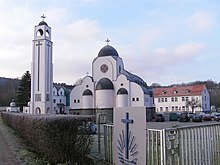
- Total: circa 1.5 million (2%)
- Orthodox Church of Constantinople/Greek Orthodox Church 450,000
- Romanian Orthodox Church 300,000
- Serbian Orthodox Church 250,000
- Russian Orthodox Church 150,000
- Bulgarian Orthodox Church 66,000
- Syriac Orthodox Church 55,000
- Armenian Apostolic Church 35,000
- Ethiopian Orthodox Tewahedo Church 13,000
- Assyrian Church 10,000
- Ukrainian Autocephalous Orthodox Church 3,600
- Coptic Orthodox Church 3,000
- Ukrainian Orthodox Church - Kyiv Patriarchate 1,000
Others

- Total: circa 0.6 million
- New Apostolic Church 400,000
- Jehovah's Witnesses 166,000
- The Church of Jesus Christ of Latter-day Saints 38,668
- Christian Community 10,000
- Apostolische Gemeinschaft 6,000
- Gemeinde Christi (Churches of Christ) 1,400
Secularism
Before World War II, about two-thirds of the German population was Protestant and one-third was Roman Catholic. In the north and northeast of Germany especially, Protestants dominated. In the former West Germany between 1945 and 1990, which contained nearly all of Germany's historically Catholic areas, Catholics have had a small majority since the 1980s. Due to a generation behind the Iron Curtain, Protestant areas of the former states of Prussia were much more affected by secularism than predominantly Catholic areas. The predominantly secularised states, such as Hamburg or the East German states, used to be Lutheran or United Protestant strongholds. Because of this, Protestantism is now strongest in two strips of territory in the former West Germany, one extending from the Danish border to Hesse, and the other extending northeast-southwest across southern Germany.

There is a non-religious majority in Hamburg, Berlin, Brandenburg, Saxony, Saxony-Anhalt, Thuringia and Mecklenburg-Vorpommern. In the eastern state of Saxony-Anhalt only 19.7 percent belong to the two big denominations of the country. This is the state where Martin Luther was born.
In eastern Germany both religious observance and affiliation are much lower than in the rest of the country after forty years of Communist rule. The government of the German Democratic Republic encouraged a state atheist worldview through institutions such as Jugendweihen (youth consecrations), secular coming-of-age ceremonies akin to Christian confirmation which all young people were encouraged to attend. The number of christenings, religious weddings and funerals is also lower than in the West.
According to a survey among German youths (aged between 12 and 24) in the year 2006, 30% of German youths believe in a personal god, 19% believe in some kind of supernatural power, 23% share agnostic views and 28% are atheists.
No religion
Main article: Irreligion in Germany- No religion specified (25-33%)
Islam
Main article: Islam in GermanyIslam is the largest non-Christian religion in the country. The majority of Muslims in Germany are of Turkish origin (63.2%), followed by those from Pakistan, countries of the former Yugoslavia, Arab countries, Iran and Afghanistan. As of 2006, according to the U.S. Department of State, approximately 3.2 million Muslims live in Germany. This figure includes the different denominations of Islam, such as Sunni, Shia, Ahmadiyya and Alevites. Studies have also shown that several thousand Germans convert to Islam annually.
Muslims first came to Germany as part of the diplomatic, military and economic relations between Germany and the Ottoman Empire in the 18th century. In World War I about 15,000 Muslim prisoners of war were interned in Berlin. The first mosque was established in Berlin in 1915 for these prisoners, though it was closed in 1930. After the West German Government invited foreign workers in 1961, the Muslim population continuously rose.
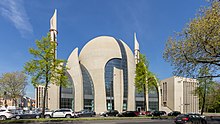
- Total: 3.6 million (4%), of which 1 million (1.1%) has German citizenship.
- Sunni 2.5 M
- Alevite 441,000
- Shi'a 225,000
- Ahmadiyya 50,000
- Ismaili 12,000
- Sufi 10,000
Judaism
Main article: History of the Jews in Germany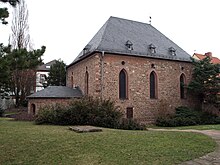
Today Germany, especially its capital Berlin, has the fastest growing Jewish community worldwide. About ninety thousand Jews from the former Eastern Bloc, mostly from ex-Soviet Union countries, settled in Germany since the fall of the Berlin wall. This is mainly due to a German government policy which effectively grants an immigration ticket to anyone from the CIS and the Baltic states with Jewish heritage, and the fact that today's Germans are seen as significantly more accepting of Jews than many people in the ex-Soviet realm. Some of the about 60,000 long-time resident German Jews have expressed some mixed feelings about this immigration that they perceive as making them a minority not only in their own country but also in their own community. Prior to Nazism, about 600,000 Jews lived in Germany, with communities going back to the 4th century.
- Total: 200,000 (0.25%)
- Union of Progressive Jews in Germany: 3,000 members
- Central Council of Jews in Germany: 23 national associations of 108 communities comprising over 100,000 members in 2013; represents most Jewish communities
Buddhism, Hinduism, other religions
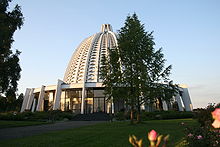
- Buddhists 245,000 (0.30%)
- Hindu 97,500
- Sikh 50,000 (see Sikhism in Germany)
- Bahá'í Faith 5,000-6,000, with one of only seven Houses of Worship in the world, see Bahá'í Faith in Germany
- Yazidi (>100,000)
Paganism
Main article: Neopaganism in German-speaking Europe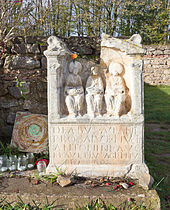
Neopagan religions have been public in Germany at least since the 19th century. Nowadays Germanic Heathenism (Germanisches Heidentum, or Deutschglaube for its peculiar German forms) has many organisations in the country, including the Germanische Glaubens-Gemeinschaft (Communion of Germanic Faith), the Heidnische Gemeinschaft (Heathen Communion), the Verein für germanisches Heidentum (Association for Germanic Heathenry) the Nornirs Ætt, the Eldaring, the Artgemeinschaft, the Armanen-Orden, and Thuringian Firne Sitte.
Other Pagan religions include the Celto-Germanic Matronenkult grassroots worship practiced in Rhineland, Celtoi (a Celtic religious association) and Wiccan groups. 1% of the population of North Rhine-Westphalia adheres to new religions or esoteric groups as of 2006.
Cults, sects, religious movements
The German government as well as the churches are actively involved in disseminating information and warnings about sects and cults (in colloquial language the German word Error: {{Lang}}: text has italic markup (help) is used in both senses) and new religious movements. In public opinion, minor religious groups are often referred to as Error: {{Lang}}: text has italic markup (help), which can both refer to destructive cults but also to all religious movements which are not Christian or different from the Roman Catholicism and the mainstream Protestantism. However, major world religions like mainstream Orthodox Christianity, Hinduism, Buddhism, Judaism and Islam are not referred to as Error: {{Lang}}: text has italic markup (help).
- Information by the Evangelische Kirche in Deutschland (Evangelic Church in Germany) and Roman Catholic Church

When classifying religious groups, the Roman Catholic Church and the mainline Protestant Evangelical Church in Germany (EKD) use a three-level hierarchy of "churches", "free churches" and Error: {{Lang}}: text has italic markup (help):
- Error: {{Lang}}: text has italic markup (help) (churches) is the term generally applied to the Roman Catholic Church, the Evangelical Church in Germany's member churches (Landeskirchen), and the Orthodox Churches. The churches are not only granted the status of a non-profit organisation, but they have additional rights as statutory corporations (Template:Lang-de), which means they have the right to employ civil servants (Beamter), do official duties or issue official documents.
- Error: {{Lang}}: text has italic markup (help) (free churches) is the term generally applied to Protestant organisations outside of the EKD, e.g. Baptists, Methodists, independent Lutherans, Pentecostals, Seventh-day Adventists. However, the Old Catholics can be referred to as a free church as well The free churches are not only granted the tax-free status of a non-profit organisation, but many of them have additional rights as statutory corporations.
- Error: {{Lang}}: text has italic markup (help) is the term for religious groups which do not see themselves as part of a major religion (but maybe as the only real believers of a major religion). Although these religious groups have full religious freedom and protection against discrimination of their members, their organisations in most cases are not granted the tax-free status of a non-profit organisation.
Every Protestant Error: {{Lang}}: text has italic markup (help) (church whose canonical jurisdiction extends over one or several states, or Error: {{Lang}}: text has italic markup (help)) and Catholic episcopacy has a Error: {{Lang}}: text has italic markup (help) ( Error: {{Lang}}: text has italic markup (help) delegate) from whom information about religious movements may be obtained.
- Information by the government
The German government also provides information about cults, sects, and new religious movements. In 1997, the parliament set up a commission for Sogenannte Sekten und Psychogruppen (literally "so-called sects and psychic groups") which delivered an extensive report on the situation in Germany regarding NRMs in 1998. In 2002, the Federal Constitutional Court upheld the governmental right to provide critical information on religious organizations being referred to as Sekte, but stated that "defamatory, discriminating, or falsifying accounts" were illegal.
See also
- Religion by country
- Evangelical Church in Germany
- History of Germany
- Lutheranism
- Martin Luther
- Max Weber
- United and uniting churches
- List of churches in Hamburg
- Irreligion in Germany
References
- worldpopulationreview.com/countries/germany-population/
- worldpopulationreview.com/countries/germany-population/
- ^ . Zensus 2011 - Page 10.
- Germany is one of the few European countries with a Jewish community that is growing. There are an estimated 250,000 Jews in Germany, half of whom are affiliated. Berlin is a favorite city among Israelis.
- Bevölkerung und Katholiken, 1965–2008
- worldpopulationreview.com/countries/germany-population/
- "Germany". Berkley Center for Religion, Peace, and World Affairs. Retrieved 28 December 2011.
- John Lotherington, The German Reformation (2014)
- Robert Kolb, Confessing the faith: reformers define the Church, 1530-1580 (Concordia Publishing House, 1991)
- Marvin R. O'Connell, Counter-reformation, 1559-1610 (1974)
- Lewis W. Spitz, "Particularism and Peace Augsburg: 1555," Church History (1956) 25#2 pp. 110-126 in JSTOR
- Peter H. Wilson, The Thirty Years War: Europe's Tragedy 2011
- Christopher Clark, Iron Kingdom (2006) pp 412-19
- Christopher Clark, "Confessional policy and the limits of state action: Frederick William III and the Prussian Church Union 1817–40." Historical Journal 39.04 (1996) pp: 985-1004. in JSTOR
- Hajo Holborn, A History of Modern Germany 1648-1840 (1964) pp 485-91
- Christopher Clark, Iron Kingdom (2006) pp 419-21
- Holborn, A History of Modern Germany 1648-1840 (1964) pp 498-509
- Douglas W. Hatfield, "Kulturkampf: The Relationship of Church and State and the Failure of German Political Reform," Journal of Church and State (1981) 23#3 pp. 465-484 in JSTOR(1998)
- John C.G. Roehl, "Higher civil servants in Germany, 1890-1900" in James J. Sheehan, ed., Imperial Germany (1976) pp 128-151
- Margaret Lavinia Anderson, and Kenneth Barkin. "The myth of the Puttkamer purge and the reality of the Kulturkampf: Some reflections on the historiography of Imperial Germany." Journal of Modern History (1982): 647-686. esp. pp 657-62 in JSTOR
- Anthony J. Steinhoff, "Christianity and the creation of Germany," in Sheridan Gilley and Brian Stanley, eds., Cambridge History of Christianity: Volume 8: 1814-1914 (2008) p 295
- Quoted in Edward Crankshaw, Bismarck (1981) pp 308-9
- John K. Zeender in The Catholic Historical Review, Vol. 43, No. 3 (Oct., 1957), pp. 328-330.
- Rebecca Ayako Bennette, Fighting for the Soul of Germany: The Catholic Struggle for Inclusion after Unification (Harvard U.P. 2012)
- Blackbourn, David (December 1975). "The Political Alignment of the Centre Party in Wilhelmine Germany: A Study of the Party's Emergence in Nineteenth-Century Württemberg". Historical Journal. 18 (4): 821–850. doi:10.1017/s0018246x00008906. JSTOR 2638516.
- Clark, Christopher (2006). Iron Kingdom: The Rise and Downfall of Prussia, 1600–1947. pp. 568–576.
- Ronald J. Ross, The failure of Bismarck's Kulturkampf: Catholicism and state power in imperial Germany, 1871-1887 (1998).
- Eastern Germany: the most godless place on Earth
- Why Eastern Germany Is The Most Godless Place On Earth
- Basic Law Art. 140
- ^ "EKD-Statistik: Christen in Deutschland 2007" (in German). Evangelische Kirche in Deutschland. Retrieved 13 February 2010.
- Konfessionen in Deutschland(German), fowid. Retrieved 2010, 9 September 2009.
- ^ "Chapter 2: Wie viele Muslime leben in Deutschland?". Muslimisches Leben in Deutschland (PDF) (in German). Nuremberg: Federal Office for Migration and Refugees (German: Bundesamt für Migration und Flüchtlinge), an agency of the Federal Ministry of the Interior (Germany). June 2009. p. 80. ISBN 978-3-9812115-1-1. Retrieved 9 September 2010.
Demnach leben in Deutschland zwischen 3,8 und4,3 Millionen Muslime beträgt der Anteil der Muslime an der Gesamtbevölkerungzwischen 4,6 und 5,2 Prozent. Rund 45 Prozent der in Deutschland lebenden Muslime sind deutsche Staatsangehörige,rund 55 Prozent haben eine ausländische Staatsangehörigkeit.
{{cite book}}: Unknown parameter|trans_chapter=ignored (|trans-chapter=suggested) (help); Unknown parameter|trans_title=ignored (|trans-title=suggested) (help) - Template:De icon Religionen in Deutschland: Mitgliederzahlen Religionswissenschaftlicher Medien- und Informationsdienst; 31 October 2009. Retrieved 19 November 2009.
- "Chapter 2: Wie viele Muslime leben in Deutschland?". Muslimisches Leben in Deutschland (PDF) (in German). Nuremberg: Federal Office for Migration and Refugees (German: Bundesamt für Migration und Flüchtlinge), an agency of the Federal Ministry of the Interior (Germany). June 2009. p. 97. ISBN 978-3-9812115-1-1. Retrieved 9 September 2010.
Der Anteil der Sunniten unter den in den Haushalten lebenden Muslimen beträgt 74 Prozent
{{cite book}}: Unknown parameter|trans_chapter=ignored (|trans-chapter=suggested) (help); Unknown parameter|trans_title=ignored (|trans-title=suggested) (help) - Blake, Mariah. In Nazi cradle, Germany marks Jewish renaissance Christian Science Monitor. 10 November 2006. Retrieved 2006-11-30.
- The Jewish Community of Germany European Jewish Congress. Retrieved 2006-11-30.
- Template:De icon Die Zeit 12/07, page 13
- Eurobarometer Biotechnology report 2010 p.381
- Bevölkerung und Kirchenzugehörigkeit nach Bundesländern Table 1.1 shows 63.4% of the German population to be Christians of which 2.2% outside the Evangelische Landeskirchen (EKD) and the Roman Catholic Church. Table 1.3 shows overview by German state of membership of the Evangelische Landeskirchen (EKD)and the Roman Catholic Church
- 80% of population in Sachsen-Anhalt is without religion
- religion by Bundesland showing non religious being the majority in Eastern Germany
- ^ REMID Data of "Religionswissenschaftlicher Medien- und Informationsdienst" retrieved 16 January 2015
- ^ Germany
- ^ Adherents.com: By Location
- ^ Adherents.com: By Location
- ^ Adherents.com: By Location
- Adherents.com: By Location
- LDS Newsroom (Germany)
- Ericksen & Heschel, Betrayal: German churches and the Holocaust, p.10, Fortress Press.
- http://www.ekd.de/download/kimi_2004.pdf
- Thomas Gensicke: Jugend und Religiosität. In: Deutsche Shell Jugend 2006. Die 15. Shell Jugendstudie. Frankfurt a.M. 2006.
- http://www.independent.co.uk/news/uk/home-news/the-islamification-of-britain-record-numbers-embrace-muslim-faith-2175178.html The Islamification of Britain: record numbers embrace Muslim faith
- State Policies Towards Muslim Minorities. Sweden, Great Britain and Germany, "Muslims in German History until 1945", Jochen Blaschke
- http://www.state.gov/j/drl/rls/irf/2007/90177.htm
- http://www.integration-in-deutschland.de/nn_285170/SubSites/Integration/EN/02__Zuwanderer/ThemenUndPerspektiven/Islam/Deutschland/deutschland-node.html?__nnn=true
- "Germany: Virtual Jewish History Tour". Jewish Virtual Library. Retrieved 22 February 2013.
- "Zentralrat-Mitglieder". Central Council of Jews in Germany. Retrieved 21 March 2015.
- "Verschiedene Gemeinschaften / neuere religiöse Bewegungen". Religionen in Deutschland: Mitgliederzahlen (Membership of religions in Germany). REMID - the "Religious Studies Media and Information Service" in Germany. 2007-8. Retrieved 2008-07-17.
{{cite web}}: Check date values in:|date=(help); Cite has empty unknown parameter:|coauthors=(help) - Die Jesiden in Deutschland - Religion und Leben Document is in German
- Altkatholiken Freikirche
- ^ Definition "Sekte"
- Final report of the commission of the Bundestag on the investigation into so-called sects and psycho groups
- Decision of the German Federal Constitutional Court: BVerfG, Urteil v. 26.06.2002, Az. 1 BvR 670/91
Further reading
- Büttner, Manfred. "On the history and philosophy of the geography of religion in Germany." Religion 10#1 (1980): 86-119.
- Drummond, Andrew Landale. German Protestantism since Luther (1951)
- Eberle, Edward J. "Free Exercise of Religion in Germany and the United States." Tulane Law Review 78 (2003): 1023+.
- Elon, Amos. The Pity of It All: A History of Jews in Germany, 1743–1933 (2002)
- Evans, Ellen Lovell. The German Center Party, 1870-1933: A Study in Political Catholicism (Southern Illinois UP, 1981)
- Evans, Richard J. "Religion and society in modern Germany." European History Quarterly 12#3 (1982): 249-288.
- Fetzer, Joel S., and J. Christopher Soper. Muslims and the state in Britain, France, and Germany (Cambridge University Press, 2005) excerpt
- Gay, Ruth. The Jews of Germany: A Historical Portrait (1992)
- Harrington, Joel F., and Helmut Walser Smith. "Confessionalization, community, and state building in Germany, 1555-1870." Journal of Modern History (1997): 77-101. online; JSTOR
- Kastoryano, Riva. "Religion and incorporation: Islam in France and Germany." International Migration Review 38#3 (2004) pp: 1234-1255.
- Latourette, Kenneth Scott. Christianity in a Revolutionary Age, I: The Nineteenth Century in Europe: Background and the Roman Catholic Phase (1959); Christianity in a Revolutionary Age, II: The Nineteenth Century in Europe: The Protestant and Eastern Churches (1959); Christianity in a Revolutionary Age, IV: The Twentieth Century in Europe: The Roman Catholic, Protestant, and Eastern Churches (1959); multiple chapters on Germany.
- Roper, Lyndal and R. W. Scribner. Religion and Culture in Germany:(1400-1800) (Brill, 2001) online
- Scribner, Robert W., and C. Scott Dixon. German Reformation (Palgrave Macmillan, 2003)
- Smith, Helmut Walser, ed. Protestants, Catholics and Jews in Germany, 1800-1914 (Bloomsbury Academic, 2001)
- Spohn, Willfried. "Religion and Working-Class Formation in Imperial Germany 1871-1914." Politics & Society 19#1 (1991): 109-132.
- Tal, Uriel. Christians and Jews in Germany: religion, politics, and ideology in the Second Reich, 1870-1914 (Cornell U.P. 1975)
- Thériault, Barbara. "Conservative Revolutionaries": Protestant and Catholic Churches in Germany after Radical Political Change in the 1990s (2004); focus on merger of GDR after 1990
External links
- Eurel: sociological and legal data on religions in Europe
- Germany - Catholic Encyclopedia
- Germany - Sacred Destinations
- Statistic by REMID about Adherence to Religious Communities in Germany
- Germans Reconsider Religion
- Religion in Germany (Deutschland): Mitgliederzahlen
- History of Pentecostal Churches in Germany
- KOKID - Kommission der Orthodoxen Kirche in Deutschland (Commission of the Orthodox Church in Germany)
- Das elektronische Informationssystem über neue religiöse und ideologische Gemeinschaften, Psychogruppen und Esoterik in Deutschland
| Religion in Europe | |
|---|---|
| Sovereign states |
|
| States with limited recognition | |
| Dependencies and other entities | |
| Other entities | |
Categories: